Want to taste some volcanic wines from a variety of countries and wine regions of Europe? And even better, have the wines all paired with food typical of that region? That is exactly what a small group of wine loving foodies recently did right here in Southwest Florida without even leaving home – or at least our home, your forkandcorkdivine.com hosts, Linda and Chuck.
There aren’t many vineyards in Southwest Florida and they certainly are not volcanic, so we had to use a little imagination. Armed with an interesting selection of recently acquired volcanic wines, a passion to  continually expand our wine knowledge and to utilize our culinary expertise, we were transported to some volcanic vineyards in Europe, many of which not many people have the opportunity to visit – let alone taste their wines. For example, when is the last time you tasted wine from the Azores? Or a tiny wine cave in Somlo, Hungary? Well that is just what we did.
continually expand our wine knowledge and to utilize our culinary expertise, we were transported to some volcanic vineyards in Europe, many of which not many people have the opportunity to visit – let alone taste their wines. For example, when is the last time you tasted wine from the Azores? Or a tiny wine cave in Somlo, Hungary? Well that is just what we did.
My husband Chuck and I recently attended a volcanic-themed wine dinner at a local restaurant where we learned about John Szabo, MS, a Canadian Master Sommelier, and his 2016 book “Volcanic Wines: Salt, Grit and Power”. The wines were so intriguing to me and the food pairings so enjoyable that I wanted to create my own volcanic wine dinner. I read Mr. Szabo’s book, did a lot of additional internet research and my “DINNER IN THE VINEYARD – Volcanic wines of Europe” event was about to become official.
It took over two months of research, sourcing appropriate wines, and deciding on geographically culturally appropriate food pairings. You can find the results of my wine research in the December 26, 2017 http://www.forkandcorkdivine.com post “VOLCANIC WINE……why should you care about an ancient volcano?” Luckily for me, some of my wine loving foodie friends were willing to come on another adventure with me and agreed to assist with food preparation and the cost of wine. The date was set, the wines arrived from around the world, and foods prepared. The family-style table was set in the Rakos vineyard (use your imagination!), wines chilled, candles lit, foods lined up in various stages of prep and the evening began.
 The end result was a five-hour wining and dining adventure that included twenty-one wines and twelve different courses of food. We started off in the Veneto (Italy), moved to the Azores and Canary Islands, then to the mainland Europe for Alsace (France), Pfalz (Germany), Somlo and Tokaji (Hungary), Sicily, Basilicata, Campania and back to the Veneto (Italy) and ended up with dessert wines from Madeira, Pantelleria and Tokaji.
The end result was a five-hour wining and dining adventure that included twenty-one wines and twelve different courses of food. We started off in the Veneto (Italy), moved to the Azores and Canary Islands, then to the mainland Europe for Alsace (France), Pfalz (Germany), Somlo and Tokaji (Hungary), Sicily, Basilicata, Campania and back to the Veneto (Italy) and ended up with dessert wines from Madeira, Pantelleria and Tokaji.
And how did we enjoy the wines, you may be wondering? Most of us have previously experienced volcanic wines from different regions around the world and have always been told that soil makes a big difference in the resulting wine, but never thought about it from the point of view that most volcanic wines display similar characteristics: salty, highly acidic, full of minerality, savory, often herbal earthiness and a density (not derived from alcohol or tannins) that can be intense, gritty, hard and unmistakable. Volcanic wines are very much in demand now and receiving attention in the wine world, so you might as well as enjoy them and savor the ash and lava!
Welcome Sparkling and Appetizer
Asiago and Prosciutto Toasts
Smoked Salmon and Mascarpone Cheese Roll-Ups
Asiago is a typical cheese of the Veneto. Both appetizers were quick 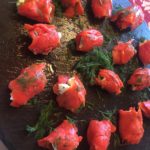 and easy to prepare. The Asiago toasts received rave reviews from our guests!
and easy to prepare. The Asiago toasts received rave reviews from our guests!
Zardetto Z Vino Spumante Rosé NV
The prosecco was made from 100% Raboso Veronese, had a pale pink raspberry color, with cherry aromas and was perfect with the appetizers. The vineyards surround the historic town of Conegliano in the Veneto. This was my first rosέ prosecco and I loved this wine. I rarely start off an event with prosecco – usually champagne, Napa sparkling or sparkling from northern Italy – but this prosecco was perfect and I’ll happily serve it again.
The Main Event
Azores and Canary Islands
Rissóis de Camarão or Portuguese Shrimp Turnovers
The Azores are Portuguese Islands about 1000 miles off the coast of Portugal and the turnovers are traditional for holidays and celebrations both in Portugal and the Azores. They are perfect for a first course cut in 3 ½ – 4 inch diameter or make them half size as I did and serve for appetizers.
2015 Azores Wine Company Isabella a Proibida (Portugal)
Only 166 cases of this red wine were made and not much of it left the islands. It is a tribute to their old field blend vines that remind the wine makers of the Isabella varietal related to American “fox grapes”. The grapes grow on wild bushy vines in almost soil-free lumps of basalt rocks. It was loaded with minerality, black pepper, hints of tomato plant, resin and smoke.
2014 Ignios Origenes Listan Negro Ycoden Daute Isora Seleccion (Spain)
The Canary Islands are Spanish and located 62 miles west of Morocco. Single grapevines are planted in the volcanic black ash soil with semi-circular rock walls around them. Not much wine leaves these islands either, so don’t expect to see wine from either island group on your local wine store shelves. The Ignios Listan Negro is from a 30-year old iron-rich vineyard on a coastal banana plantation. It is salty with herbal raspberry, sour cherries, red beets, pepper, and did I ever taste the ashy smoky funky earth! Listan Negro is the most planted red grape there.
Alsace, France
Alsatian Tart Flambέe with Alsatian Cheese
A tarte flambέe is a typical Alsatian flatbread topped with fromage blanc, a fresh tart spreadable cheese, thinly sliced onions and bacon. It is rolled out very thinly and usually cooked in a wood burning oven, hence the translation to “pie baked in the flames”. Unfortunately we had only our conventional oven so no flames! Flaming or not, it made an absolutely delicious tart. Our tart was made by Anita, a local foodie friend whose husband has relatives in Alsace and visits there regularly. The Alsatian cheese was even served on an “Oncle Hansi” china stork plate. It seems that Jean-Jacques Waltz, aka “Hansi” was a French artist of Alsatian origin famous for his quaint drawings. You can see some of his original artwork in the Village of Hansi and his Museum in the city of Colmar or on this Villeroy and Boch Hansi D’Alsace stork plate.
2012 Zind Humbrecht Clos St. Urbain Grand Cru Rangen Pinot Gris
Alsace is located about 300 miles due east of Paris and is a few miles from both Germany and Switzerland. The town of Thann in southern Alsace displays the clearest evidence of volcanism and a single vineyard, the Rangen de Thann Grand Cru, has reigned supreme for a thousand years. The 12-acre walled vineyard of Clos Saint Urbain provides wine that consistently rates in the mid to high 90s. The 2012 Pinot Gris was rated 94 by Robert Parker and gave us honeyed ripe pears and delicate flint with a big saline finish.
2013 Domaine Schoffit Clos St. Theobold Grand Cru Rangen Riesling
The 16-acre Clos Saint Theobald of Domaine Schoffit produces similarly highly rated wines. This 2013 Riesling, rated 97 points by Wine Advocate, gave us ripe white fruit notes, crushed rocks with a dry powerful flinty almost salty aftertaste. You can expect Rieslings from the Rangen to be consistently higher in ash and minerality when compared to Rieslings of other regions.
Pfalz, Germany
Sauteed German Bratwurst and Weisswurst Sausages with Bacon and Apple Sauerkraut and Red Beet Salad
These dishes are typical of the Pfalz region. Bratwurst is a sausage made from finely minced pork and veal seasoned with onion and Weisswurst are short, greyish white sausages made from a mixture of finely minced pork and veal seasoned with parsley, onions, and fresh lemon. Sauerkraut is often served in Germany. I can remember my parents making homemade fermented sauerkraut in a big crock every year when I was a child. Cooking it with apple and bacon is typical of the Pfalz. Most recipes call for juniper berries. If you don’t have them, simply substitute a little gin!!! My research said to use one teaspoon gin for every 2 berries. The red beet salad is commonly found as a side dish in Germany. Chuck prepared it in true German style!
2015 Dr. Bürklin-Wolf Wachenheimer Riesling
The Pfalz, otherwise known as the Palatinate, lies just under Pechsteinkopf, a basaltic volcano. It has become one of the more inventive and exciting wine regions in Germany. Long gone are the days of Blue Nun! Now you will get quality Rieslings like this one from the 400 year old property of Dr. Bürklin-Wolf that is one of the EUs largest biodynamic-certified wine estates. They are located in the village of Wachenheim and make top quality Rieslings like this 2015 with fresh apple and peach aromas, flavors of mango, peach and spice all with clean minerality and elegant acidity.
2013 Friedrich Becker Estate Pinot Noir Pfalz
Only 24% of Pfalz vineyards are planted in Riesling. Red wine varieties such as Spätburgunder (Pinot Noir) and Dornfelder continue to increase. Friedrich Becker is one of the top Pinot Noir producers in Germany. Becker is located almost in Alsace – in fact 70% of their vineyards are actually in Alsace! The soil in this vineyard is chalky limestone and our bottle of 2013 Estate Pinot Noir was full of strawberry and bright cherry fruit with a hint of tobacco and dusty earthiness. Our guests really enjoyed it.
Hungary
Tάrkonyos Gombaleves (Tarragon Mushroom Soup)
Paprikas-Tejfolos-Csirkeporkolt (Paprika Sour Cream Chicken Stew)
Hungarian food displays a melting pot of elements just like the United States. There are German, Italian, Slavic and ancient Asiatic roots with regional differences on top of that. People here were nomads in ancient times cooking over open fires. Hungarians love soup; soups, stews/goulash play a big part in the Hungarian menu. The tarragon mushroom soup was typical of Hungarian cooking and was a good pairing for all of our white varietal Hungarian wines. One ingredient that you do not cook without in Hungary is paprika, the country’s “national spice”. It’s a red powder made from grinding dried sweet red peppers; used as a garnish and seasoning. The color varies from bright orange-red to deep red, depending on the peppers used. Commercial paprika comes from several countries, but Hungarian paprika is thought to be the finest, and will be labelled as from the Szeged region. In Hungary there are six classes or types of paprika ranging from delicate to hot. You will find paprika in this mushroom soup we served as well as the paprika sour cream chicken stew, both made by Tom, one of our foodie winelovers who toured Hungary a few years ago and took cooking classes in Budapest. Both dishes were tasty delights!
There are 22 wine regions in Hungary but we concentrated on two of their finest volcanic regions: Tokaj-Hegyalja and Somlo. Hungarian wines have been described as colorful and varied. There are a number of indigenous white varieties with late ripening, distinctive, aromatic fruit and floral scents and some bold red full bodied varieties. They are all rich in minerals due to the volcanic rocks you find almost everywhere. Hungary was under Communist rule for 40 years and not known for their wine except one – Tokaji Aszu – which we have on our dessert menu, so more to come about this famous wine. Our first three wines come from Somlo, nicknamed Witness Mountain, the smallest Hungarian appellation. It is one of the smallest, most beautiful and remote regions specializing in traditional wood-aged powerful dense white wines – Furmint, Harslevelu and Juhfark.
2011 Istvάn Spiegelberg Wedding Night, Somlo
The Spiegelberg Wedding Night wine is a blend of the three varietals – Furmint, Harslevelu and Juhfark. Spiegelberg works everything by hand and ages his grapes in Hungarian oak barrels to the sounds of Gregorian chamber music. All of his wines are heady, dense and gripping with smoky minerality and brininess. The 2011 Wedding Night Is a blend of honeyed fruit, flowers, orange blossoms, dried herbs, salt and smoke. Tradition says that drinking this wine on your wedding night guarantees the birth of a boy! I’m not looking for children, let alone a boy, but I really did love this wine! Our winelover friends, Tom and Ellen, actually visited this winery, ate a meal in the wine cellar and listened to the Gregorian chanting. You can read about their visit at hobberdogchronicles.royhobbs.com.
2014 Somlόi Apάtsάgi Pince Hárslevelü, Somlo
Apάtsάgi was originally owned by the Benedictine Pannonhalma Archabbey, then expropriated and redistributed during Communism. Zoltan Balogh, grandson of a previous winemaker, bought it and brought it back to life. The grapes are late harvested, fermented and aged in oak, then bottled unfiltered to fully express the terroir. Hárslevelü means “linden tree leaf,” and refers to the shape of the grape leaves. According to Jancis Robinson, in The Oxford Companion to Wine, “Good Hárslevelü is typically deep green-gold, very viscous, full and powerfully flavored”. It should have a highly aromatic fruity aroma with notes of elderflower and lime tree blossoms. This 2014 had peachy aromas, with hints of honey, sweet notes of pineapple, pear and strawberry, was faintly spicy on the palate, and had more elegant acids than Furmint with some tartness in the finish. It’s a more oily and concentrated, bright and powerful wine. While not related, you might find it similar to Gruner Veltliner or a Chenin Blanc.
2015 Tornai Premium Juhfark, Somlo
Endre Tornai started out with a one-acre vineyard and now owns 56 acres of volcanic rock soil. Wines made here all have a distinctive “Somlo” taste. Juhfark is a variety of grape, mainly found in Hungary, most prominently in this tiny wine region of Somló. The name literally means “sheep’s tail” in Hungarian and refers to the elongated, cylindrical shape of the clusters. It is considered a transparent grape–it takes on the characteristics of the place it is grown. In Somló, the juhfark grapes get good sun, producing a rich wine with strong minerality and hints of saltiness. Juhfark wines often give hints of apple and pear and are floral yet herbal. It pours a deep gold and smells like overripe white fruit and smoke. Juhfark Premium is Tornai’s flagship wine. It is age-worthy and full of minerality. The wine is a blend of stainless steel and oak aged Juhfark. The 2015 showed overripe aromas on the nose, underlined by stony notes, very complex on the palate, a round acidity and a long finish.
2015 Bott Csontos Furmint, Tokaji
Furmint is a white Hungarian wine grape variety that is most widely grown in the Tokaj-Hegyalja wine region. It has been used to make the world famous Tokaji sweet dessert wines for centuries but is now also being used used to produce single-varietal dry wines as well. Furmint ranges in color from pale straw to light amber, with aromas of pineapple, lemon blossom, orange rind, ripe pear, white peach, yellow peach and apricot. The clay and volcanic soil also imparts a chalk-like texture with a mineral backbone. Jόzsef and Judit Bodό make Bott Csontos on three acres of steeply sloping old vines. They till the soil with horses and use a traditional wooden Hungarian press and native yeasts to ferment the wine in oak barrels. The 2015 Csontos has a chalk-like texture with dried fruit, honey, spice, citrus notes and lots of minerality. They have reached their goal of making true-to-place wines.
Sicily, Italy
Smashing Pumpkin Pasta with Ricotta Cheese
When searching for the perfect Sicilian dish to pair with our Mount Etna wines without duplicating the foods of Basilicata and Campania, I came across a list of Sicilian recipes on “The Thinking Traveler” website. Much to my surprise I discovered that The Thinking Traveler is a villa rental company in the Mediterranean and has won Condé Nast Traveler awards in 2016 & 2017. So if you want to rent an amazing villa in Sicily, The Thinking Traveler is the place to call! They also have wonderful recipes on their website and I settled on this one for “smashing pumpkin pasta”. I posted a picture of my practice dish, tagged them on Instagram, and they graciously responded to say it is one of their favorite recipes based on a dish they serve at their Villa Don Arcangelo all’Olmo. For actual food prep, I found organic pie pumpkins at The Fresh Market, cut them up like butternut squash and sautéed them until soft enough to lightly “smash” but not puree. Added some really creamy fresh ricotta and was rewarded with a delightful pumpkin pasta sauce.
2014 Tenuta di Fessina Etna Erse Bianco Etna DOC
We already agree that there are many highly rated Italian wines, and we don’t really need to find a good reason to drink more of it! However Italy is one of the world’s most volcanically active wine regions. The only active volcanoes in mainland Europe are in Italy. Sicily has one of those most active volcanoes and it is still growing. Mount Etna now reaches almost 11,000 feet above the sea. The main white grape here is Carricante and it has lots of stony flavors and salinity. There are two lava flows that wrap around Tenuta di Fessina. The grapes here grow in lava stones, volcanic ash and sandy loam between 2900-3300 feet up the hillside. This 2014 Erse Bianco was made from 80% Carricante grapes with 20% Catarratto and Minnella and displayed straw-yellow with green hues, crisp aromas of pear and savory saline notes with a long textural finish that is typical of a volcanic wine. It was delicate and paired well with the pumpkin sauce on the pasta and the ricotta cheese.
2015 Tenuta di Fessina Etna Erse Rosso Etna DOC
The 2015 Erse Etna Rosso was made from 80% Nerello Mascalese, the main red grape of Sicily, and 20% Nerello Cappuccio. It was typical for an Etna Rosso with bright ruby-red color, aromas of crushed berries, plums and lots of smoky minerality. It has a lengthy elegant finish. I remember the Etna Rosso profile well from our “Sangiovese Grapes across Italy” wine event when we learned that Nerello Mascalese is most likely a cross between the Sangiovese grape and one other varietal. The Fessina winemaker worked with Angelo Gaja for two decades so comes with some great credentials!
Basilicata, Italy
Eggplant Parmigiana
Basilicata is mostly agricultural and very sparsely populated. The food  here is rustic like many areas of Italy. There are a number of theories as to where eggplant Parmigiana originated, but we opted for this pairing since it is served all over southern Italy and Mariann’s eggplant went really well with our Basilicata wine, Aglianico.
here is rustic like many areas of Italy. There are a number of theories as to where eggplant Parmigiana originated, but we opted for this pairing since it is served all over southern Italy and Mariann’s eggplant went really well with our Basilicata wine, Aglianico.
2012 Bisceglia Aglianico del Vulture Gudarra
The Bisceglia estate is located on the lower slopes of Mount Vulture, an extinct volcano. Gudarra means “to be enjoyed” in the local dialect, and we did indeed. Aglianico is the only varietal permitted here and the vines are grown in the traditional trellising method “vigna a capanno” which consists of three posts tied together like a tripod over a single vine. 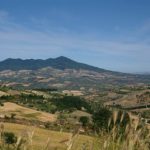
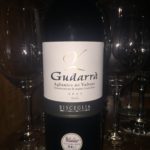 Two of the posts can be moved around throughout the growing season to shade the grapes from the sun and fierce winds. Aglianico is full-bodied and known for savory flavors of leather, white pepper, black fruits, cured meats, smoke, ash and cigar box. This 2012 Gudarra was no exception. It was a deep ruby red with violet hues and notes of red cherries, blackberries, cassis and sweet spice. It paired beautifully with the tomato-sauced eggplant Parmigiana.
Two of the posts can be moved around throughout the growing season to shade the grapes from the sun and fierce winds. Aglianico is full-bodied and known for savory flavors of leather, white pepper, black fruits, cured meats, smoke, ash and cigar box. This 2012 Gudarra was no exception. It was a deep ruby red with violet hues and notes of red cherries, blackberries, cassis and sweet spice. It paired beautifully with the tomato-sauced eggplant Parmigiana.
Campania, Italy
Mozzarella and Tomato Caprese with Sauteed Vegetables
Neapolitan Meatballs
Lentils with Italian Sausage
According to my culinary pairing research, no visit to Naples and the Campania region would be complete without a Caprese salad and Neapolitan meatballs.
You can serve Mozzarella Tomato Caprese as a cold hors d’oeuvre, a salad, side dish or entrée. Since the Campani eat a lot of vegetables, Carol’s addition of sautéed vegetables was perfect for our pairing. Lentils are eaten all across Italy so seemed to be a great addition to our menu especially when searching for items easily transportable by our foodie guests. Crockpots are a wonderful invention! There are many variations of meatballs throughout Italy but our foodie guest Jo made hers fork tender Neapolitan style with pine nuts. Debbie slowly simmered our lentils with vegetables and some sweet Italian sausage. All in all a delicious homage to Campania.
2016 Mastroberardino Falanghina del Sannio DOC
The soils in every area of Campania have been influenced by volcanos, and Mastroberardino has been growing grapes and making wine here dating back to 1760. Today they are a regional leader dedicated to making wine from the ancient indigenous varietals. One of these is Falanghina, which many believe to have been the basis for the 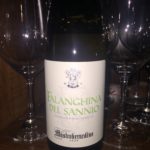 legendary Falernian wine prized by ancient Rome due to its unique profile and fragrance. This 2016 from the Falanghina del Sannio DOC was pale lemon-green with aromas of ripe pineapples, citrus fruits and white flowers. It had zesty acidity with notes of honeysuckle and almonds. Thank goodness it was not like the ancient Falernian which was about 30 proof, aged for 15-20 years and oxidized to amber dark brown.
legendary Falernian wine prized by ancient Rome due to its unique profile and fragrance. This 2016 from the Falanghina del Sannio DOC was pale lemon-green with aromas of ripe pineapples, citrus fruits and white flowers. It had zesty acidity with notes of honeysuckle and almonds. Thank goodness it was not like the ancient Falernian which was about 30 proof, aged for 15-20 years and oxidized to amber dark brown.
2016 Mastroberardino Lacryma Christi del Vesuvio Bianco DOC
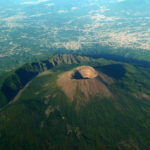 Mount Vesuvius is the most famous volcano in the region and can be seen from every area in the Bay of Naples. This 2016 Lacryma Christ del Vesuvio Bianco DOC is made from 100% Coda di Volpe grapes grown in layers of volcanic ash. Just as expected, we tasted dusty stones with a gritty mouth feel. It was pale yellow with aromas of pear and other white fruit. It’s a food friendly wine that paired especially well with the mozzarella caprese and sauteed vegetables. According to one legend, God cried when he looked down and saw the beautiful Bay of Naples giving us this wonderful Lacryma Christi, tears of Christ.
Mount Vesuvius is the most famous volcano in the region and can be seen from every area in the Bay of Naples. This 2016 Lacryma Christ del Vesuvio Bianco DOC is made from 100% Coda di Volpe grapes grown in layers of volcanic ash. Just as expected, we tasted dusty stones with a gritty mouth feel. It was pale yellow with aromas of pear and other white fruit. It’s a food friendly wine that paired especially well with the mozzarella caprese and sauteed vegetables. According to one legend, God cried when he looked down and saw the beautiful Bay of Naples giving us this wonderful Lacryma Christi, tears of Christ.
2014 Fattoria Galardi Terra di Lavoro Roccamonfina IGT
The Galardi wine comes from about 1500 feet up on Roccamonfina’s volcanic slopes and is 80% Aglianico with a 20% addition of Piedirosso. The Galardi family produces just this one wine! Terra di Lavoro means “land of work” and this grey tufo with deposits of pumice and ash adds to the challenging environment. Piedirosso is the next most planted red grape in Campania after Aglianico and is said to be a very difficult varietal. This 2014 bottle was typically really big and full-bodied with a deep purple color, smoke, earth, hints of tobacco, ripe black fruit, and we can’t leave out the mineral notes similar to crunchy graphite. We paired it with our meatballs and Italian sausage but an aged piece of beef would have been perfect!
Soave, Veneto, Italy
Creamy Risotto with Crab and Shrimp
Soave pairs incredibly well with rich Italian seafood like clams, scallops, crabmeat and other shellfish especially in creamy rich  dishes. Pasta is not as popular in northern Italy as the south, and rice reigns supreme. Arborio rice (risotto) is as essential to the Venetian cuisine as it is to the dishes of the
dishes. Pasta is not as popular in northern Italy as the south, and rice reigns supreme. Arborio rice (risotto) is as essential to the Venetian cuisine as it is to the dishes of the  Piedmont and Friuli. So considering all that, this risotto with crabmeat and shrimp made even creamier by the addition of mascarpone cheese couldn’t be beat!
Piedmont and Friuli. So considering all that, this risotto with crabmeat and shrimp made even creamier by the addition of mascarpone cheese couldn’t be beat!
2015 Suavia Soave Classico Monte Carbonare
The Soave DOC was created in 1968 and requires a minimum of 70% Garganega grapes in the bottle. 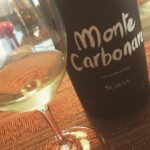 This 2015 Suavia is 100% Garganega grown on the Monte Carbonare Hill in black as coal soil. We absolutely loved this wine; it was probably one of the favorites of the evening. It was yellow-straw in color with citrus, herbs and minerals, and a creamy elegance – truly an expression of its volcanic terroir.
This 2015 Suavia is 100% Garganega grown on the Monte Carbonare Hill in black as coal soil. We absolutely loved this wine; it was probably one of the favorites of the evening. It was yellow-straw in color with citrus, herbs and minerals, and a creamy elegance – truly an expression of its volcanic terroir.
Formaggi e Frutta e Dolci
Broadbent Rainwater Madeira (Madeira, Portugal)
Stilton Cheese, White Chocolate and Candied Grapefruit
Madeira Island is the top of a massive volcano located 600 miles from mainland Portugal and 300 miles from Morocco. It is famous for Madeira, its fortified wine made there for 550 years. The basalt bedrock has yielded extremely fertile soils. Grapevines grow on pergolas in narrow green terraces up and down the sides of the hills. Each terraced strip has a narrow dry stonewall to keep it from washing down to the sea. While there are numerous types of Madeira we opted to taste “Rainwater” which is medium dry and more of a value-driven entry level Madeira for this dinner. We enjoyed a Broadbent Rainwater which received 90 points from Robert Parker.  Made from the Tinta Negra grape, it was aged for three years in oak casks, is reddish-copper in color and has scents of dried dates, figs, cumin and a finish of honey and walnuts. I loved this as an after dinner drink and am now wondering how much more I would enjoy a 10 year old Malmsey! I paired the dessert wines with cheese and chocolate – specifically Stilton cheese, white chocolate and candied grapefruit for Madeira – a delicious pairing!
Made from the Tinta Negra grape, it was aged for three years in oak casks, is reddish-copper in color and has scents of dried dates, figs, cumin and a finish of honey and walnuts. I loved this as an after dinner drink and am now wondering how much more I would enjoy a 10 year old Malmsey! I paired the dessert wines with cheese and chocolate – specifically Stilton cheese, white chocolate and candied grapefruit for Madeira – a delicious pairing!
2014 Donnafugata Passito di Pantelleria Ben Ryέ (Pantelleria, Sicily)
Blue Cheese and Chocolates
Pantelleria is a satellite island 62 miles southwest of Sicily and is part of the same volcanic chain. It is famous for the Moscato Passito di Pantelleria made from Zibibbo grapes. Zibibbo grapes are the oldest continually existing unmodified grape still in vinification and are also known as Muscat of Alexandria. Part of the Moscato is harvested when ripe, pressed and juice set aside while remaining Moscato is laid on mats and dried in the sun. This 2014 Donnafugata Ben Ryέ was neon-orange in color and a favorite of our group. It had aromas of apricots and candied citrus zest with notes of Mediterranean scrub, honey and fresh figs. Robert Parker gave it 95 points and so did we! Ben Ryέ is an international icon for Italian dessert wines and the name comes from the Arabic term for “Son of the Wind”. We enjoyed it with the Blue Cheese and chocolates.
2006 Oremus Tokaji Aszu 5 Puttonyos (Tokaji, Hungary)
Roquefort Cheese and Nutty Toffee Date Cake
Tokaji Aszu is Hungary’s most famous wine and they have been making it for over 500 years. Louis XIV called it the “Wine of Kings and King of Wines”. It’s made from botrytized grapes that grow in 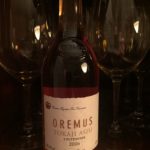 volcanic soil at the foot of the Zemplen Hills. There are miles of underground wine cellars and centuries-old wine making traditions. Oremus has been owned by the Alvarez family who also owns Vega-Sicilia, one of Spain’s most famous estates, since 1993. Our 2006 Oremus Vega Sicilia Tokaji Aszu 5 Puttonyos was rated 95 points by Robert Parker. Puttonyos measure sweetness so this one had 12-15% residual sugar. It also had aromas of white flowers, honey and dried apricots with flavors of apricot nectar and lemon curd. I paired it with a French Roquefort cheese and my homemade nutty toffee date cake with toffee sauce – a marriage made in heaven!
volcanic soil at the foot of the Zemplen Hills. There are miles of underground wine cellars and centuries-old wine making traditions. Oremus has been owned by the Alvarez family who also owns Vega-Sicilia, one of Spain’s most famous estates, since 1993. Our 2006 Oremus Vega Sicilia Tokaji Aszu 5 Puttonyos was rated 95 points by Robert Parker. Puttonyos measure sweetness so this one had 12-15% residual sugar. It also had aromas of white flowers, honey and dried apricots with flavors of apricot nectar and lemon curd. I paired it with a French Roquefort cheese and my homemade nutty toffee date cake with toffee sauce – a marriage made in heaven!
Sicilian Ricotta Cheesecake
Strazzate Basilicata Chocolate Almond Cookies
Strawberries, Blackberries and Grapes
My foodie friend Debbie would have made any Sicilian grandmother proud with her Sicilian Ricotta Cheesecake.  Ricotta is very popular in Sicily as we have already learned from our smashed pumpkin pasta with ricotta. Therefore it is no surprise that our Sicilian cheesecake should be ricotta-based as well. The Strazzate are chocolate almond cookies traditionally served in Basilicata.
Ricotta is very popular in Sicily as we have already learned from our smashed pumpkin pasta with ricotta. Therefore it is no surprise that our Sicilian cheesecake should be ricotta-based as well. The Strazzate are chocolate almond cookies traditionally served in Basilicata. 
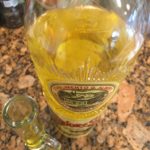
They are flavored with Strega, an herbal liqueur produced in Benevento, the capital town of Campania. It is made from a secret recipe of the Alberti family for almost 140 years. It certainly helped to make these cookies extremely tasty little morsels!
Our five hour volcanic wine extravaganza is now complete! However, these were only volcanic wines of Europe. We have an entire other hemisphere to conquer one of these days. Who knows when, but it will eventually happen. In the meantime, stay tuned to forkandcorkdivine.com to find out where our next wine adventure will take us.
I must also acknowledge the Blue Danube Wine Company (Los Altos, CA) for without them, there would have been no Hungarian wine tasting. They are my go-to wine source for most of the obscure hard-to-find wines that have been served. Naples Wine Collection (Naples, FL) was the source for our Italian volcanic wines – all from Marcello Palazzi and The Winebow Group. Other items came from 67 Wine (NY) and B-21 Wine Company (Tarpon Springs, FL). Some of my greatest inspiration for learning about, finding and tasting wines from obscure countries are the folks at Exotic Wine Travel and several regular contributors to #winelover and other on-line wine groups. The internet and social media have proven to be an excellent source of information and inspiration for me. If you have any questions about the wines served at our dinner, please contact me at the email address listed below.
#volcanicwine, #bluedanubewine, #exoticwinetravel
1.23.18 LFRakos@gmail.com

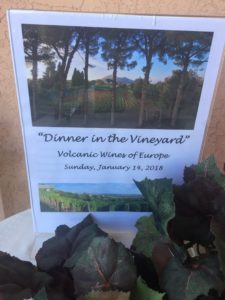

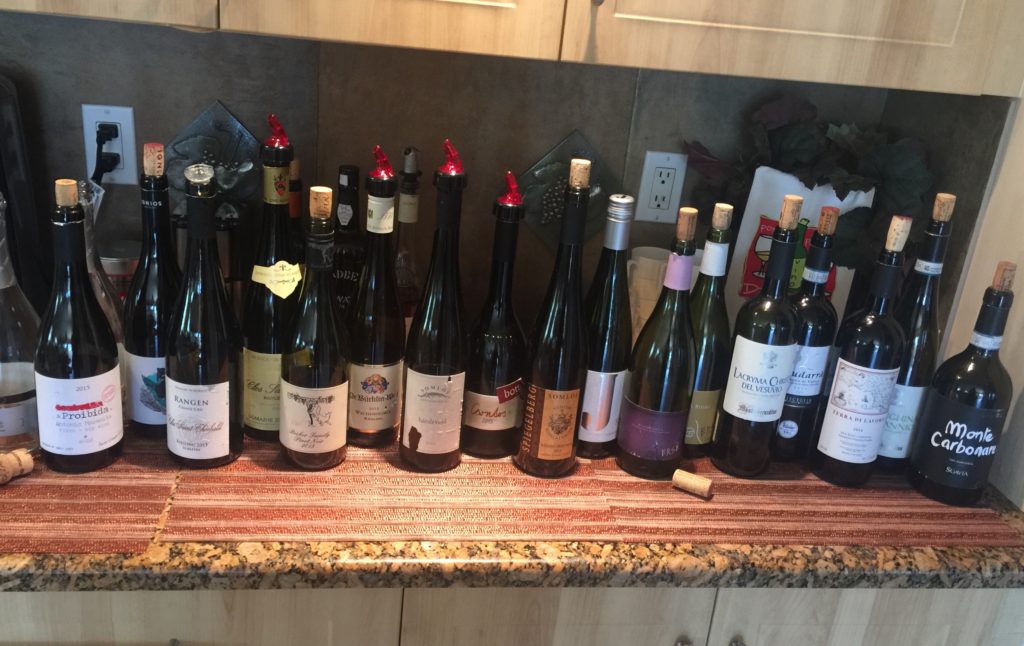
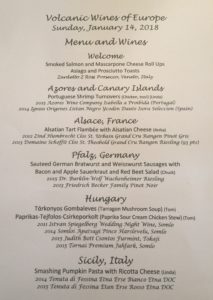
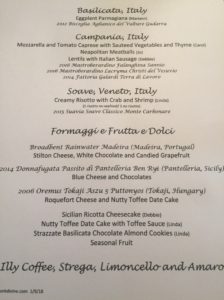

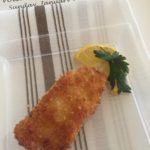
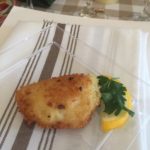
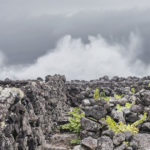
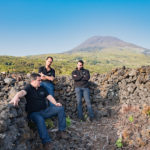
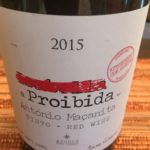
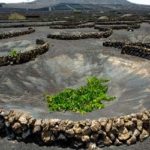
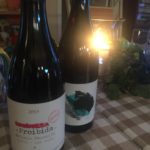
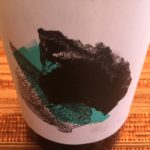

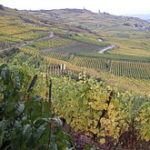
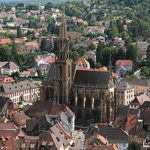

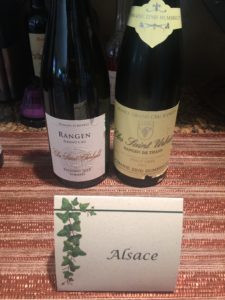
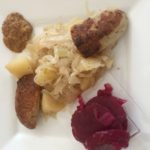
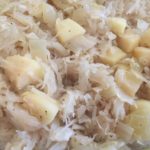
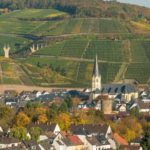
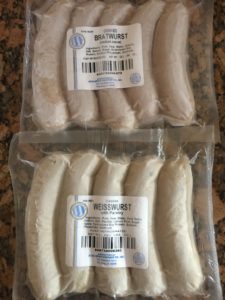
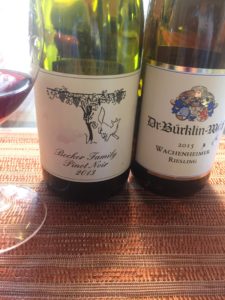
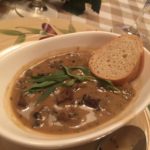
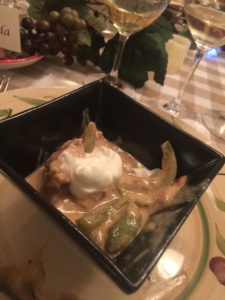
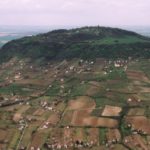
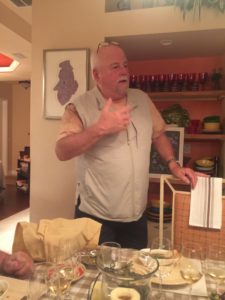
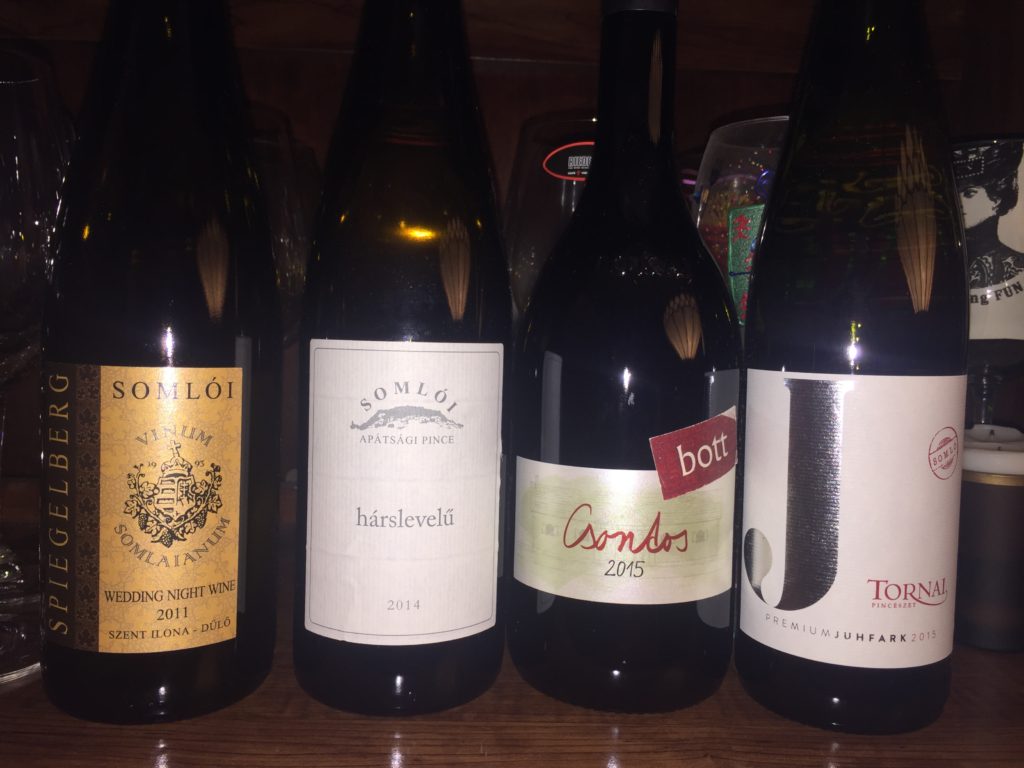
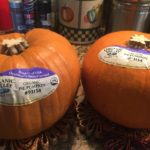

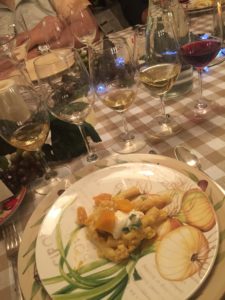
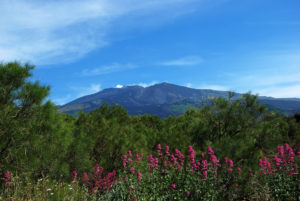

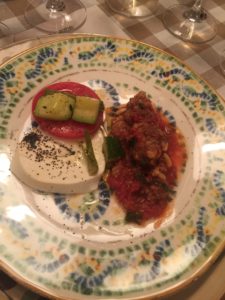
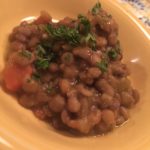

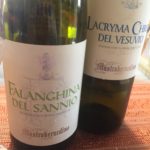
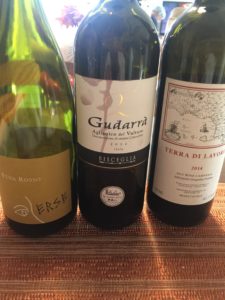
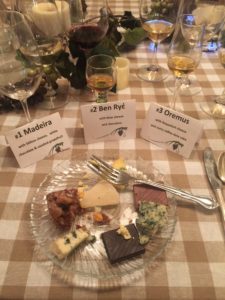
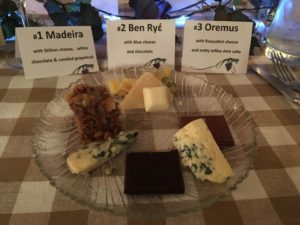
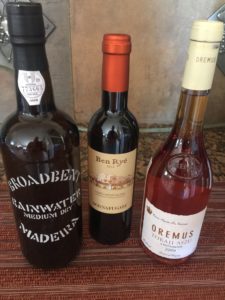
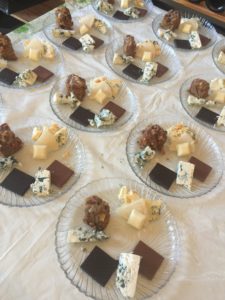
 Cooper, our “dinner in the vineyard” assistant who made our evening so much more enjoyable! Thank you, Cooper.
Cooper, our “dinner in the vineyard” assistant who made our evening so much more enjoyable! Thank you, Cooper. 
